Few places can compete with Cartagena for perennial allure. Ever since it was established as a colony by the Spanish in 1533, this sultry jewel on Colombia’s Caribbean coast has seduced centuries of visitors.
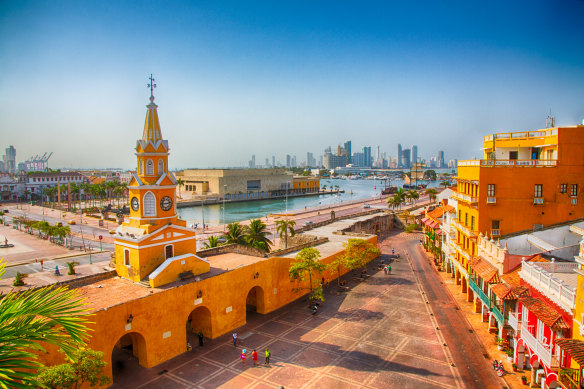
The Clock Tower Gate, Cartagena, Colombia.Credit: iStock
It became such an important trading post that the Spanish had to build the largest fortress in any of its colonies simply to protect it from the relentless attacks by pirates and foreign armies.
Today, it’s ambushed by a different threat: tourists. As a popular inclusion on many Caribbean and Central America cruise itineraries (it’s the final port on my Aurora Expeditions cruise from Costa Rica), its UNESCO World Heritage-listed old town is regularly besieged by large tour groups – and for good reason.
It’s one of the best-preserved historic cities in the Americas, a captivating tangle of cobbled streets filled with grand churches, shady plazas and gorgeous pastel mansions. Visiting Colombia and not going to Cartagena would be travel heresy.
But just know that it’s not the only gem on the country’s Caribbean coast. To the east lies lesser-known treasures – lush rainforest harbouring some of the world’s rarest birds, the planet’s highest coastal mountain range and indigenous communities that have only recently emerged from self-imposed exile. Ready to explore?
Days one to three: Of toucan spotting and mountain sunsets
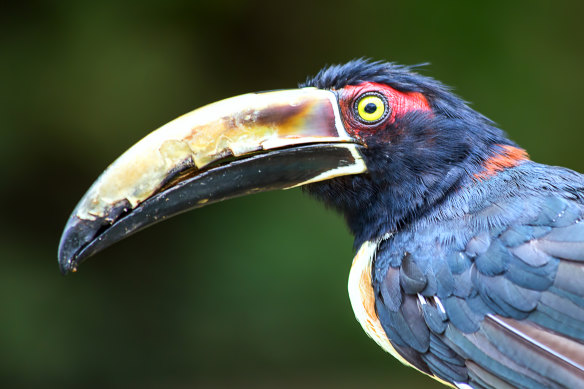
Colombia is a bird-watcher’s paradise ... a collared aracari.Credit: iStock
It starts before we even get out of the car. As we follow the snaking road from the coastal city of Santa Marta up into the foothills of the Sierra Nevada de Santa Marta mountains, my guide Cristian from local tour operator Impulse Travel regularly gestures towards the dense tropical rainforest lining the road.
“Keel-billed toucan,” he says, between mouthfuls of breakfast arepa. A few seconds later: “Collared aracari.”
Our destination is a small nature reserve near Minca, a sleepy mountain town that has become a popular backpacker haunt in recent years. We reach the reserve about 8am (late by birding standards), but we’re still bombarded by a concerto of whistles, tweets, clicks and beeps as soon as we leave the car.
I lose track of the number of species we see during our hour-long stroll through the forest, but it includes some of the area’s endemic superstars, such as the Santa Marta brushfinch and the groove-billed toucanet.
Colombia is legendary in birding circles because it’s home to the world’s highest number of species (exact figures vary, but it’s over 1900).
More than 600 can be found here in the Sierra Nevada mountains, including an unusually large number of endemic species (27, according to Cristian) because it was once surrounded by an inland sea.
Getting here requires effort. There’s only one access road, the 22-kilometre winding route from Santa Marta, which itself is a 4.5-hour drive east of Cartagena.
At least it’s paved now. It used to be a dirt track, which quickly turned into a treacherous quagmire during one of the regular afternoon downpours. The reward? The delightful town of Minca, a bohemian hamlet surrounded by thick jungle and a dramatic cluster of snow-dusted peaks.
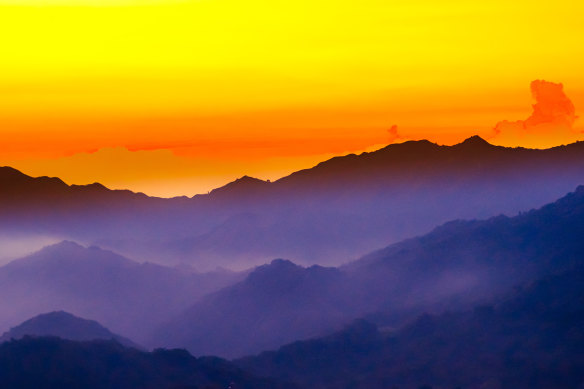
Minca, Colombia.Credit: iStock
Backpackers discovered it around a decade ago, which has led to a network of impressive hostels and boutique hotels, a sprinkling of laidback eateries (including an unexpectedly good French bakery) and a handful of organised tours.
Despite its burgeoning popularity, it’s still the kind of place where you’ll see a farmer walking his donkey down the main drag, scattering chickens as they go.
Popular activities include a guided tour of the nearby La Victoria coffee farm, a self-sustaining plantation that still uses machinery brought over from the UK in the late 1800s, and taking a motorbike taxi up into the mountains to watch the sunset.
There are also many jungle hikes to swimming holes and waterfalls, although they start early because many get busy with Colombian day-trippers seeking a respite from the coastal heat.
Minca is the sort of town that people visit and then forget to leave. One such character is Jose Gustavo Perez, the entertaining 83-year-old owner of rustic eatery Asadero Camarita. Originally from Colombia’s cattle-farming country, he specialises in the lowland’s cowboy cuisine of slow-cooked pork, ribs and chorizo.
The restaurant is also known for its special “dessert” – a marijuana joint. He’s been smoking pot since he was 12, and he credits the lifelong habit with his enduring good health.
To prove the point, he lights one up, lets out a high-pitched “yeehaw” and unleashes an impressive karate kick. Clearly, I’ve been following the wrong advice.
Days four to five: A walk on the rock star wildlife side
Sometimes nature creates an area of such improbable beauty that you feel like giving it a standing ovation. Tayrona National Park is one such spot.
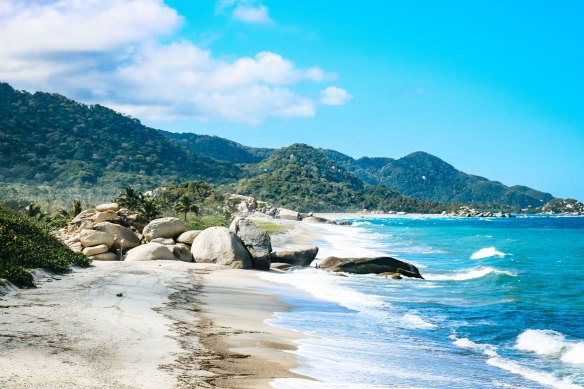
Tayrona National Park: improbable beauty.Credit: Alamy
Encompassing 180 square kilometres of land and ocean where the Sierra Nevada mountains plunge into the Caribbean Sea, it contains a rare diversity of habitats, from montane and cloud forests to mangrove swamps and pristine beaches.
Consequently, it’s home to a prodigious variety of wildlife, including more than 100 species of mammals, around 30 different reptiles and over 300 types of birds.
Thanks to its proximity to Santa Marta (less than an hour away), it can also be home to a lot of people, particularly during December and January when Colombians traditionally go on holiday.
It’s equally popular with backpackers, many of whom stay overnight in hammocks or tents in one of the basic beachside campsites. For the rest of us, a mid-week day trip is the best option, beginning early to get a head start on the crowds and the heat.
Cristian ensures we’re at El Zaino (one of the park’s three entrances) when it opens at 8am. As a result, we pass only a handful of people as we wind our way through the forest on a mixture of dirt trails and boardwalks.
It doesn’t take long before we stumble across one of the park’s wildlife rock stars – the endemic cotton-top tamarin monkey. With its brooding gaze and comical shock of white hair, it could be the front man for a simian Billy Idol tribute band.
Once again, there’s a list-ticking frenzy of birdlife, from a rufous-tailed jacamar to a whooping motmot, as well as countless lizards and a Central American agouti (a large rodent), that wanders nonchalantly across our path.
As we approach the coast, pockets of dense mangrove start to appear, their roots crawling with blue-legged crabs.
Our destination is Cabo San Juan, the most famous of Tayrona’s string of postcard beaches and one of the few that you can swim at (many have dangerous rips).
It’s notable for its pair of opposing bays, which are separated by a dramatic rocky headland. It takes us almost three hours to get there, by which time the humidity has rendered me a sweat-soaked hot mess and I eagerly cool off with a dip.
Given how few people we saw during the hike in, I’m surprised at how crowded the beach is and a little disappointed to find a sprawling campsite with dozens of tents and a large restaurant.
My advice? Head for one of the quieter bays where you can appreciate nature’s handiwork with fewer distractions.
Day six: Here cometh the Kogi men
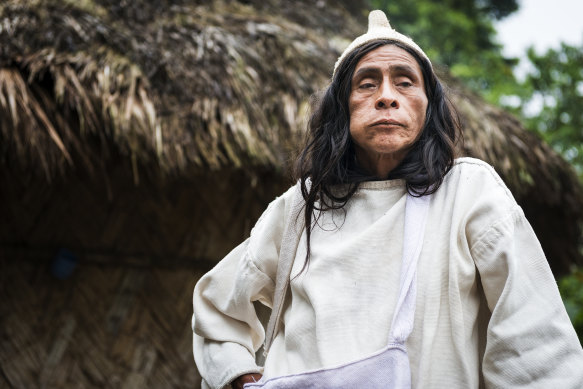
A Kogi Shaman: that they still exist is a miracle.Credit: iStock
Spend any time in this part of Colombia and you will inevitably come across members of the Kogi, one of four indigenous tribes descended from the original Tairona pre-Columbian civilisation that thrived in the area before the Spanish arrived.
Numbering about 20,000, they mainly live in remote settlements in the Sierra Nevada mountains but occasionally come down to the coast to buy supplies.
As we travel around the region, we see a handful of Kogi men, always dressed in traditional white tunic and pants, handmade woollen bags slung over their shoulders, trudging along the roadside in sandals or wellington boots.
That they still exist is something of a miracle given they’ve been relentlessly persecuted by everyone from Spanish colonisers and drug cartels to Colombia’s own government.
Even after retreating deep into the mountains, they were often caught in the crossfire of the decades-long conflict between the guerillas and the paramilitary.
Given all this, you’d understand if they wanted to keep to themselves. For a long time they did, living simple, subsistence lives with an intensely spiritual respect for nature.
Meanwhile, the rest of the planet continued to pollute and plunder until eventually the Kogi broke their self-imposed exile to warn people about the impending environmental catastrophe via a 1990 BBC documentary called From the Heart of The World - The Elder Brothers’ Warning.
After their message went unheeded, they tried again in 2012 with a film they made themselves called Aluna.
Since then, the Kogi have allowed limited interaction with outsiders, and Cristian is one of the few guides they permit to visit with tourists.
After a bumpy drive along a rough dirt road shadowing the Ancho River, we leave the car and hike uphill for 40 minutes to reach Tungaka, a Kogi settlement of 80 or so circular mud huts with thatched palm roofs.
Cristian has brought some bread as a gift, so we’re immediately surrounded by an excited group of barefoot children, all identically dressed in simple white tunics. The adults, on the other hand, pay us little attention. The women continue weaving; most of the men are out in the fields farming.
Over a picnic lunch by a nearby river, Cristian explains some of the Kogi’s beliefs and customs, which include strategically burying pieces of cotton to maintain environmental harmony and a meditative practice of coating a wooden gourd with a mixture of chewed cocoa leaves and lime.
All in all, it’s the least “tour-like” community visit I’ve ever experienced. There’s no traditional welcome, no dances, no gift shop – just an insight into an ancient culture that treats our home with the respect it deserves.
Days seven to eight: Carnivals, chicharron and conversion
I lose track of the number of times I’m told not to bother visiting Barranquilla. Instead, I should head to Santa Marta, its more photogenic neighbour, where I’ll find attractive beaches and 16th-century colonial architecture.
But I’m intrigued. Surely, Colombia’s fourth largest city and biggest port must have some redeeming features? And it does. You just have to look a little harder to find them.
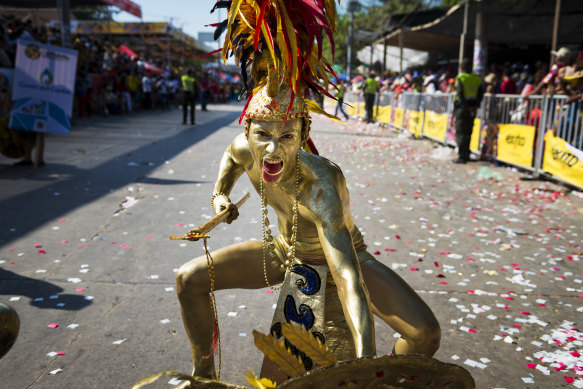
Barranquilla is home to Colombia’s biggest carnival.Credit: iStock
Barranquilla’s biggest claim to fame is that it hosts the country’s largest carnival, an exuberant four-day riot of dancing, parades and partying that’s so impressive UNESCO awarded it a World Heritage listing.
Even if you don’t visit for the event (held a few days before Ash Wednesday), you can learn more about its history and see examples of the elaborate costumes worn by the annual Carnival Queen at the excellent Carnival Museum.
To help me break through Barranquilla’s gritty, port-city facade, I recruit the services of Andrea Vivero, founder of local operator Caribia Tours.
Over the course of a day, she shows me another side to the city, starting with the ornate pastel mansions built by European immigrants in the historic El Prado district.
We also visit the glamorous Beverly Hills-esque Hotel el Prado, drink the best coffee of my trip at an artisanal roaster called La Casa En El Cielo (The House in Heaven) and feast on regional specialities including chicharron (deep-fried pork belly) and cayeye (mashed plantain banana-like fruits) at Cucayo, a popular chain restaurant overlooking the Magdalena River.
The experience reminded me of the reaction I often got from people when I told them I was heading back to Colombia. Isn’t it dangerous? What’s there to see? Why not just go to Peru or Chile?
During my eight-day trip along the coast, I never once feel unsafe and experience wildlife, landscapes and cultures you simply can’t find in any other South American nation. For this Colombian convert, the country’s perennial allure endures.
Five more classic Colombian destinations
Medellin
Cradled by the yawning Aburra Valley, Medellin has shrugged off its violent narcos past to become one of Colombia’s most innovative metropolises, with first-class museums, parks and an enviable spring-like climate.
Salento
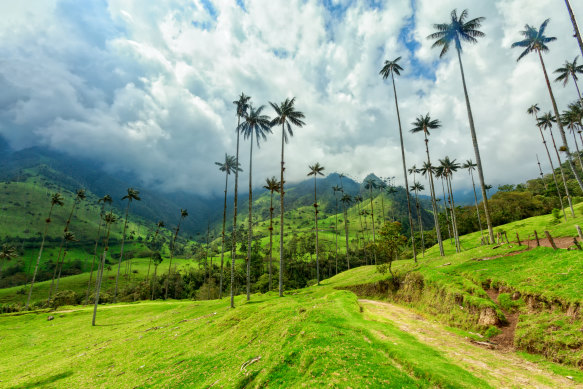
Salento is the gateway to Colombia’s best coffee plantations.Credit: iStock
Located in the heart of the country’s lush, UNESCO World Heritage-listed coffee growing region, the quaint town of Salento is the gateway to Colombia’s best coffee plantations. It’s also the starting point for tours to the spectacular Cocora Valley, home to the world’s tallest palm trees.
The lost city
It’s a strenuous three-day jungle trek to reach this sacred city hidden deep in the Sierra Nevada mountains, but the reward is an impressive 32-hectare archaeological site built by the Tairona people that dates back to 800AD.
Bogota
A bit like Barranquilla, Colombia’s busy capital suffers by comparison with its prettier siblings, Medellin and Cartagena, but it’s still a vibrant city with grand squares, excellent museums and the atmospheric La Candelaria historic quarter.
Rosario Islands
Located an hour off the coast of Cartagena, this collection of 27 idyllic islands offers spectacular snorkelling and diving in a protected marine park. Visit on a day-trip or, better still, enjoy a few days in a beachfront resort.
THE DETAILS
TOUR
Local specialist Impulse Travel can create a bespoke itinerary along Colombia’s Caribbean coast including accommodation, transfers and tours with English-speaking guides. See impulsetravel.co/en
CRUISE
Aurora Expeditions’ 15-day Costa Rica and The Panama Canal cruise from San Jose, Costa Rica to Cartagena departs April 19, 2024. From $20,295 a person, twin share. See auroraexpeditions.com.au
FLY
Several airlines fly from Australia to Cartagena via the US or Chile, including United Airlines and LATAM. See united.com; latamairlines.com
CLIMATE
Note that Colombia’s Caribbean coast is hot and humid year-round, with daily temperatures averaging around 32 degrees. Visit between December and April for the least rain.
MORE
The writer was a guest of Aurora Expeditions, Pro Colombia and Impulse Travel.
Sign up for the Traveller Deals newsletter
Get exclusive travel deals delivered straight to your inbox. Sign up now.